Amongst the cat’s family, the big cats belong to Panthera genus and the small & medium cats are from Felis genus, cheetahs are the only cats that belongs to a unique genus of Acinonyx. The high-speed savannah hunters are the easiest to spot and the least dangerous of all big cats. These cats can sprint up to a speed of 120 kilometers per hour (75 miles per hour) and accelerate to 90 kilometers per hour (60 miles per hour) within three seconds.
Cheetahs can be easily spotted in the wild grasses on Masai. It is because they can be spotted hunting during the day unlike nocturnal predators who stay away from the open grasslands in the day. The easiest way to avoid any confusion between a cheetah & a leopard is that cheetahs have a black line running down their eyes across their face, which is a very distinctive feature. It is not just an aesthetic feature but has functional use as it acts as an anti-glare while they are sprinting.
Cheetahs are the smallest of all the big cats. The lighter body weight combined with the sleek & slender structure, keeps them nimble and thereby, the fastest of all. Due to this reason, they prefer small to medium game animals like impalas, Thomson gazelles, wildebeest calves. Wildebeest calves get the added advantage of travelling in the herds & mothers with protective instincts which requires a lot more strategy or luck where the calf is separated from the herd.
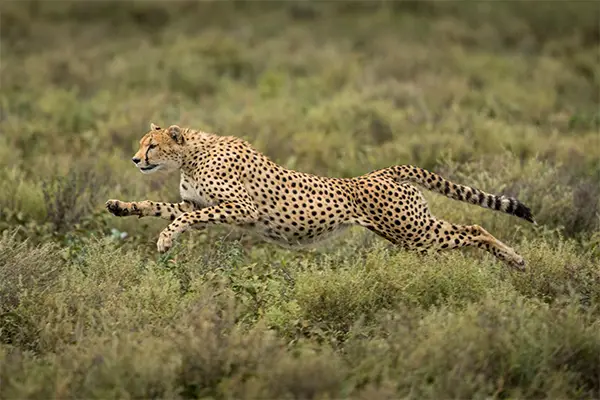
1. All big cats except Cheetahs have fully retractable claws – the claws are protected under the sheath of skin when not hunting, climbing, or scratching. The cheetahs on the other hand have semi-retractable claws, as this body feature helps them to gain more traction when sprinting at high speeds. It’s more like a running spike for sprint shoes. In addition to the claws, the body of cheetahs is a piece of an artwork as they have a flexible spine. It helps the hind legs for longer sprint as it flexes & straightens while sprinting.
2. Another interesting feature is that cheetahs purr instead of roar. Their voice box is fixed, which gives out sound of purring, grunting, screaming as it vibrates with air flowing in and out. The voice box for other big cats- lions, jaguar, leopard, tigers have larger muscle and long fold making it possible to sound a roar.
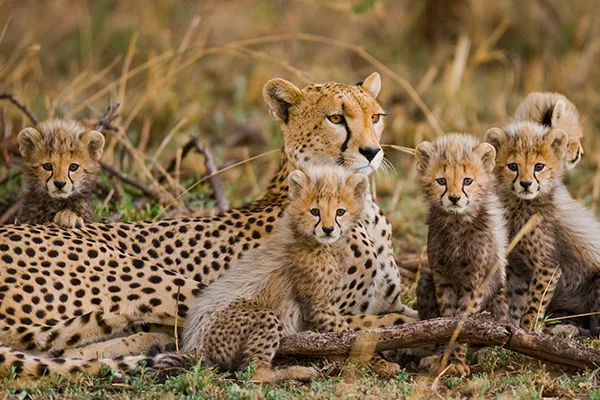
3. Cheetahs hunt on the plain grasslands where they stalk, observe, chase & hunt the prey. Due to the speeds & area they cover while hunting, cheetahs are said to have the larger range among the big cats. The average home range for a Cheetah is 2700 square miles depending upon whether it’s a female of male and if the coalition is bigger, the range goes upwards.
4. Cheetahs are diurnal hunters, meaning they hunt both during the dawn & dusk. This behavior is one of the responses to the ecosystem where there are larger predators in the vicinity like lions and leopards. In case there are no nocturnal predators, cheetahs prefer hunting during the dark hours. It would be better to call them the “opportunistic” hunters.
Tano Bora is the coalition of 5 cheetahs and is the largest male coalition of Masai Mara. Cheetahs generally do not form group bigger than 2-3 members. This coalition was said to be formed in 2016, of 2 strong males along with 3 younger males, witnessed first in the Northern Serengeti. Over the period, they traversed through the plains of Serengeti before claiming the territory in Masai Mara. The five brothers are Olapadan (“Great Shooter” in Maa), Olarishani (“Judge” in Maa”), Olonyok (“The one who puts efforts to achieve better results” in Maa), Leboo (“The one who is always within the group” in Maa) and Winda (“Hunter” in Kiswahili).
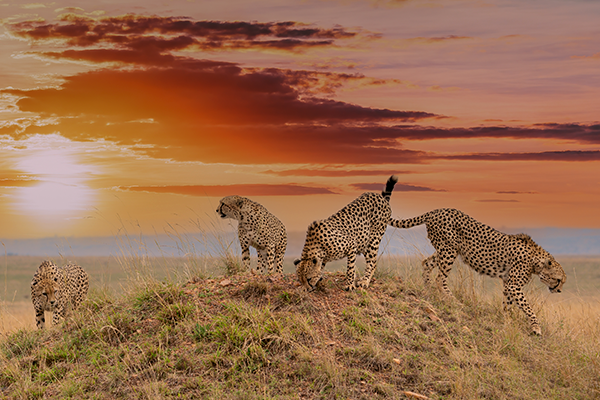
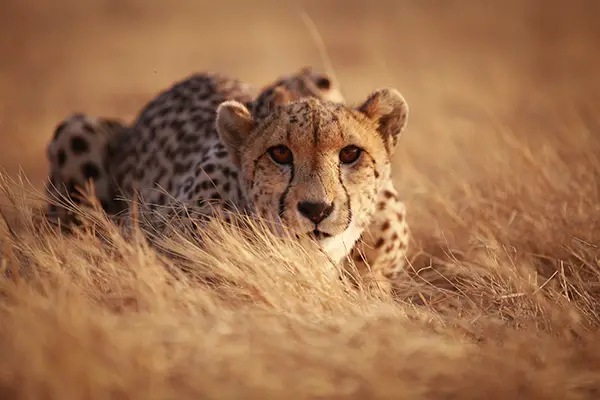
Olapadan being the youngest of the lot soon became the leader of the coalition. He was the one to initiate the hunt and lead the group. Olarishani soon became the confidante of the leader & thus the co-leader. He was also the peacemaker of the group, trying to resolve the feuds that would crop up due to unstable hierarchies, hunting strategy or the mating rights. Both males would make the decision on which direction to follow for prey & territories. The dominance hierarchy within the coalition took a shift around 2009 when Olapadan was regularly attacked by Leboo & Winda injuring him gravely that needed medical attention. This injury did take away Olapadan’s position from leader to the lowest of ranking within the group.
This strong coalition was the most loved by tourists to spot as it was one of the largest coalition and unusual too. Each one of them brought in their skills & experience that taking down a wildebeest a day during the wildebeest migration was no sweat for these 5 brothers. With the onset of 2022, the coalition was cut down to three members only. Around January 2022, Olapadan was found dead with severe injuries. Nobody witnessed the end of it but there is a possibility that the fight broke out within the group & rivalry amongst themselves lead to his death. Further in February 2022, Olarishani was discovered seriously injured by the guides. It is suspected that he succumbed to injuries in a crocodile attack while crossing the Ol Talek river. Now, “The Magnificient Five” has reduced to three but there will be more tales to come around with the shifts in hierarchy of the coalition.
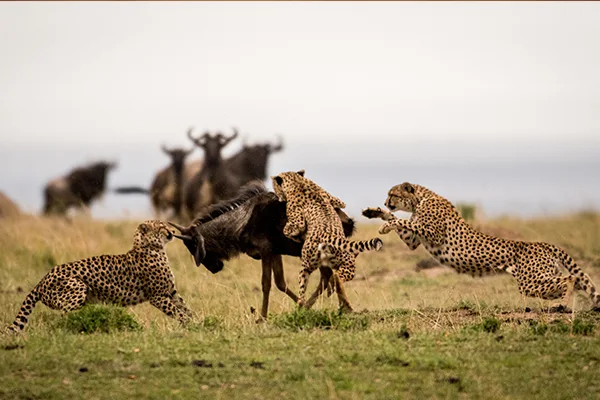
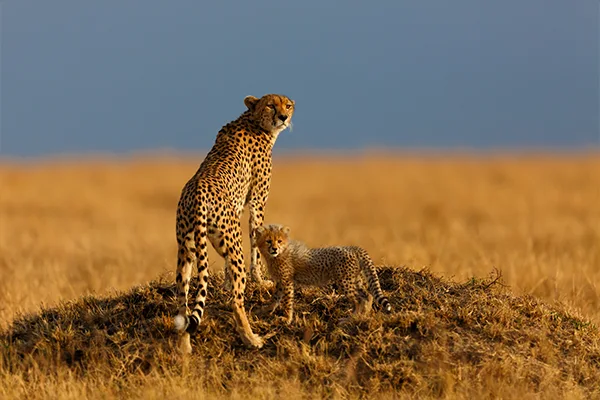
Malaika was the most loved, super mom and a great hunter of its time. Malaika was the cheetah featured in the BBC documentary “The Hunt”. She is known to jump off the safari jeeps and use it as a vantage point to stalk for preys. This became a fun game for Malaika over the period & has never hurt any humans in this deal. However, the authorities have laid out instructions to guides to avoid such behavior and is now, no new generation of cheetahs is jeep jumper. The female cheetahs are always solitary and only go along with their cubs till their adolescence (18-20 months). The mortality rate for cubs to their adolescence is more than 90%. This is because they run solitary and are sometimes not able to provide enough food for the cubs as the mother must hunt for herself & the whole litter. Also, when on hunt, the cubs are an easy prey for other predators and are easily hunted down. The unique thing about Malaika is that she has raised her whole litter to adulthood when the chances of it are 10% or lesser. The same runs down in her bloodline. Kisaru, the descendant of Malaika has been able to raise her whole litter to adolescence. It is a skill set that run through their genes.
As per the latest IUCN list, cheetahs have been put in the Red List which represents them in vulnerable state. In the past, cheetahs’ population has gone extinct in Europe and North America leaving their existence only in Asia & Africa. Around 19th century, it was estimated to be 100,000 which is now reduced to lesser than 8000 cheetahs living in the wild in the 21st century. This turn of events is led by low rate of reproductive success, climate change, hunting by humans, and habitat destruction. With this limited population, inbreeding has become one of the survival skills which further reduces the size of gene pool.
It is our responsibility to minimize the damage that we cause to these amazingly gracious animals. We encourage to not disturb and distress the wild by interfering in their ecosystem. The reserve authorities have laid out trails for vehicles and tourists to embark upon and we abide by it strongly for the comfort & respect for the wild.

We offer the best offers with specially curated tours. Come and experience the wild and the beauty of Africa.
Book Now